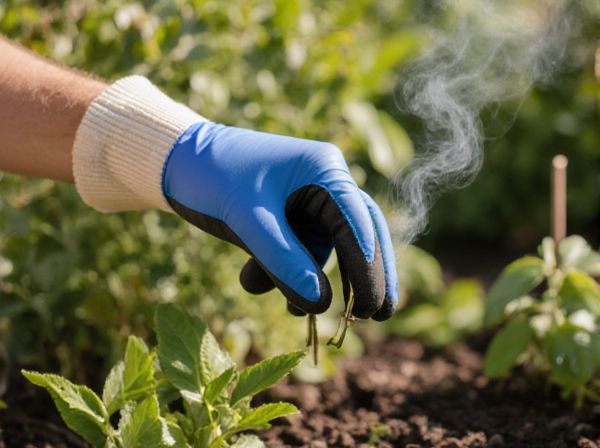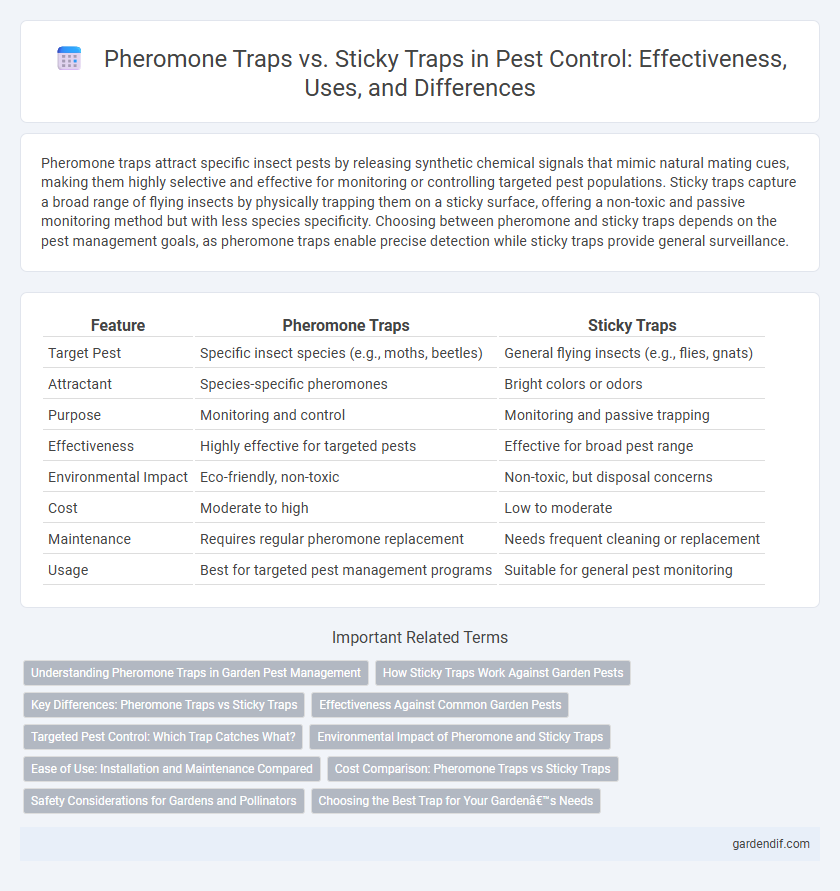
pheromone traps vs sticky traps Illustration
Pheromone traps attract specific insect pests by releasing synthetic chemical signals that mimic natural mating cues, making them highly selective and effective for monitoring or controlling targeted pest populations. Sticky traps capture a broad range of flying insects by physically trapping them on a sticky surface, offering a non-toxic and passive monitoring method but with less species specificity. Choosing between pheromone and sticky traps depends on the pest management goals, as pheromone traps enable precise detection while sticky traps provide general surveillance.
Table of Comparison
| Feature | Pheromone Traps | Sticky Traps |
|---|---|---|
| Target Pest | Specific insect species (e.g., moths, beetles) | General flying insects (e.g., flies, gnats) |
| Attractant | Species-specific pheromones | Bright colors or odors |
| Purpose | Monitoring and control | Monitoring and passive trapping |
| Effectiveness | Highly effective for targeted pests | Effective for broad pest range |
| Environmental Impact | Eco-friendly, non-toxic | Non-toxic, but disposal concerns |
| Cost | Moderate to high | Low to moderate |
| Maintenance | Requires regular pheromone replacement | Needs frequent cleaning or replacement |
| Usage | Best for targeted pest management programs | Suitable for general pest monitoring |
Understanding Pheromone Traps in Garden Pest Management
Pheromone traps target specific insect pests by mimicking their mating signals, enabling precise monitoring and control in garden pest management. These traps reduce non-target captures compared to sticky traps, which indiscriminately trap various insects, including beneficial species. Utilizing pheromone traps allows for timely interventions, minimizing pesticide use and promoting sustainable pest control strategies.
How Sticky Traps Work Against Garden Pests
Sticky traps work against garden pests by using a highly adhesive surface that captures insects when they come into contact with it, preventing their movement and reducing pest populations. These traps are effective in monitoring and controlling flying pests like aphids, whiteflies, and fungus gnats by disrupting their life cycles and limiting reproduction. Positioned strategically around plants, sticky traps provide an eco-friendly, pesticide-free method for protecting gardens from infestations.
Key Differences: Pheromone Traps vs Sticky Traps
Pheromone traps use species-specific chemical attractants to lure pests, enabling targeted monitoring and control, while sticky traps rely on adhesive surfaces to capture a broad range of insects indiscriminately. Pheromone traps are highly effective for early pest detection and population tracking, particularly in agricultural and stored product environments, whereas sticky traps provide a simple, non-chemical method suitable for general pest surveillance indoors. The selective nature of pheromone traps minimizes non-target captures, making them more efficient for integrated pest management (IPM), whereas sticky traps may require frequent replacement due to debris accumulation.
Effectiveness Against Common Garden Pests
Pheromone traps effectively target specific garden pests by mimicking their mating signals, leading to precise monitoring and control of species such as moths and beetles. Sticky traps, while less selective, capture a wide range of flying insects including whiteflies, aphids, and fungus gnats, offering broad-spectrum pest management. Combining both trap types enhances pest control by providing targeted detection and capturing diverse pest populations in gardens.
Targeted Pest Control: Which Trap Catches What?
Pheromone traps are highly effective for targeted pest control by emitting species-specific chemical signals that attract only the intended insect, such as moths or beetles, making them ideal for monitoring and reducing populations of particular pests. Sticky traps capture a broader range of flying insects like whiteflies, fungus gnats, and aphids by using a sticky surface but lack species specificity, which can lead to catching non-target beneficial insects. Choosing between pheromone and sticky traps depends on whether precise pest identification and targeted elimination or general pest reduction is the goal.
Environmental Impact of Pheromone and Sticky Traps
Pheromone traps target specific pest species by emitting synthetic chemical signals, significantly reducing non-target insect captures and minimizing ecological disruption. Sticky traps, while effective in capturing a broad range of insects, often result in higher collateral damage to beneficial species and contribute more to environmental waste due to their disposable adhesive surfaces. The selective nature of pheromone traps promotes integrated pest management practices that are more environmentally sustainable and reduce pesticide reliance.
Ease of Use: Installation and Maintenance Compared
Pheromone traps are generally easier to install and maintain because they attract specific pest species using targeted scents, reducing frequent replacement and cleanup. Sticky traps require regular monitoring and replacement as they capture a wide range of insects indiscriminately, often resulting in quicker saturation and messier disposal. The selective attraction of pheromone traps minimizes maintenance effort, making them more user-friendly for ongoing pest management.
Cost Comparison: Pheromone Traps vs Sticky Traps
Pheromone traps generally have a higher upfront cost than sticky traps due to the specialized chemicals used to attract specific pests. Sticky traps are more affordable and widely available, making them suitable for large-scale or budget-conscious pest control efforts. However, pheromone traps often provide more targeted and effective monitoring, potentially reducing long-term pest management expenses.
Safety Considerations for Gardens and Pollinators
Pheromone traps target specific pest species, minimizing harm to beneficial insects and pollinators, making them safer for garden ecosystems. Sticky traps can unintentionally capture non-target insects, including important pollinators like bees and butterflies, posing a greater risk to garden biodiversity. Choosing pheromone traps supports pest control while preserving pollinator populations and overall garden health.
Choosing the Best Trap for Your Garden’s Needs
Pheromone traps target specific insect species by releasing synthetic sex attractants, making them highly effective for monitoring and controlling pests like moths and beetles in gardens. Sticky traps capture a wide range of flying insects using a coated adhesive surface, offering a broad-spectrum pest management solution but with less specificity. Selecting the best trap depends on your garden's pest species, desired control precision, and whether you need targeted monitoring or general insect reduction.
pheromone traps vs sticky traps Infographic

 gardendif.com
gardendif.com